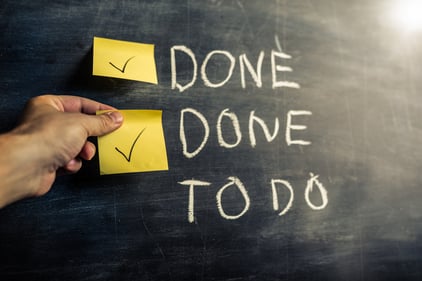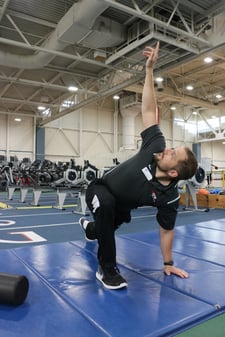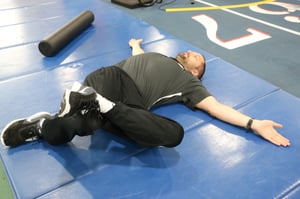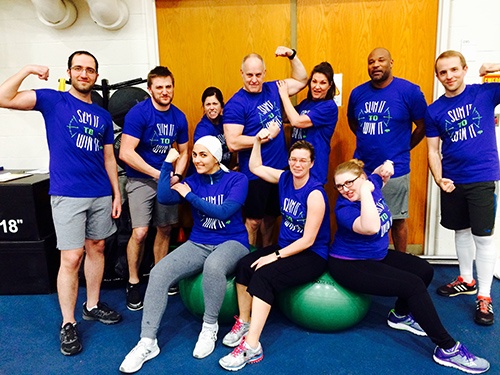 Welcome to the final installment of the productivity series. If you need a second to catch up, check out these posts regarding action (productive) vs. motion (busy), the Ivy Lee Method for prioritizing, and the Pomodoro Technique for time management. But if you’re all up to speed, we’ll dive right in!
Welcome to the final installment of the productivity series. If you need a second to catch up, check out these posts regarding action (productive) vs. motion (busy), the Ivy Lee Method for prioritizing, and the Pomodoro Technique for time management. But if you’re all up to speed, we’ll dive right in!
Feeling Ashamed of Falling Short
Up to this point, I’ve covered topics and methods that are all geared toward the act of being productive. But what happens when you fall short of the productivity goals that you set for yourself?
Maybe you’ve stared down at the to-do list on your desk and asked yourself, “How did I only get this much done today?” Maybe you start to beat yourself up, or scold yourself like a parent would their kid. If you’ve ever found yourself in this position, you are not alone. Many high achievers have described themselves as having an “internal cattle prod” when it comes to their own productivity, constantly pushing themselves to do more and go further, until finally they reach an unsustainable pace. Researchers have coined the term productivity shame in regard to this phenomenon. But why do so many of us experience this feeling with regard to work?
A Productivity Expert on the Causes of Productivity Shame
Jocelyn K. Glei is an author, lecturer, and host of the podcast Hurry Slowly. She researches and presents on ways to optimize productivity and creativity, and how to be more resilient in the workplace and in our daily lives. She describes productivity shame as “a toxic substance that slowly corrodes your ability to take any joy in your work.” She cites examples that may sound all too familiar to some, such as committing to a workload that you intuitively know is unrealistic. Or maybe you set an incredibly challenging goal for yourself (not inherently a bad thing) but you fail to set up a structure for support or accountability, then berate yourself for failing to reach that goal.
Glei has run into this numerous times with students in her class and those with whom she consults in the workplace. She cites potential causes as our instant-gratification culture, one that is fueled by social media and technology. If we have to wait for something to download because the internet connection is weak, if our Instagram post doesn’t get a certain amount of likes right away, if we have to wait longer than 2 minutes in a drive-thru line, its nearly to the point where some feel accosted by these things. It’s downright annoying. Over time, we may slowly be wiring ourselves to expect this same level of speed when it comes to our creativity and productivity—which only sets us up for failure.
Tips for More Realistic Productivity
So how can you combat productivity shame? How can you be more realistic in both the workplace and in your daily life when it comes to your to-do’s? Here are a few techniques you can use today to avoid productivity shame:
- Limit your to-do List to only the absolutely necessary things. Try the Ivy Lee Method the night before, but limit it to your big-ticket items, and no more than two or three. The more on your list, the more likely that guilt will creep in at the end of the day.
- Set aside designated time within your day to work only on those two or three big to-do’s. If you work in an office, have a closed-door policy for an hour. If you work from home, set a timer, put the phone in a drawer out of sight, and close out unnecessary tabs on your computer. Those small, seemingly insignificant distractions add up in a big way.
- Find an accountabili-buddy. This can be someone in the workplace or your personal life who can act as a check-in for you on the way to your goals. Having a physical means of accountability can help you stay on track, whether it’s a project at work or a side hustle at home.
- Get up and move! Sometimes a short workout or even a walk can stimulate ideas, clear your mind, and spur creativity.
Give a few of these a try, and see if that inner guilt trip voice of “shoulda-woulda-coulda" quiets down for a bit.
This blog was written by Lauren Zakrajsek, NIFS Health Fitness Instructor, Personal Trainer, and Internship Coordinator. To learn more about the NIFS bloggers, click here.


 If you’re trying to lose weight, you’ve probably started exercising, maybe you’re trying a new diet, and maybe you’ve been super consistent for months now, but nothing’s changing. You feel like you’re doing everything right, but you haven’t seen any changes on the scale. How can this be? Weight loss is all about diet and exercise, so why aren’t the pounds just falling off? Research suggests there’s more to weight loss and weight management than diet and exercise alone.
If you’re trying to lose weight, you’ve probably started exercising, maybe you’re trying a new diet, and maybe you’ve been super consistent for months now, but nothing’s changing. You feel like you’re doing everything right, but you haven’t seen any changes on the scale. How can this be? Weight loss is all about diet and exercise, so why aren’t the pounds just falling off? Research suggests there’s more to weight loss and weight management than diet and exercise alone. Most workout formulas include a warmup process. If hip mobility is a focus, your workout would benefit from a few additions to the routine. Foam rolling, which has been around for a while, is a great way to get blood circulating to the muscles and decrease soreness (if you worked them out prior). Spending a few minutes to roll out the trigger spots (areas of higher tenderness) will help you feel better, and you will be able to exercise on a more consistent basis.
Most workout formulas include a warmup process. If hip mobility is a focus, your workout would benefit from a few additions to the routine. Foam rolling, which has been around for a while, is a great way to get blood circulating to the muscles and decrease soreness (if you worked them out prior). Spending a few minutes to roll out the trigger spots (areas of higher tenderness) will help you feel better, and you will be able to exercise on a more consistent basis. Second, I would suggest a dynamic movement stretch (rather than traditional static stretching) to help not only stretch the muscle, but also warm up the body for more movement. “The
Second, I would suggest a dynamic movement stretch (rather than traditional static stretching) to help not only stretch the muscle, but also warm up the body for more movement. “The  Finally, another great stretch to do is simply called a
Finally, another great stretch to do is simply called a  heard that exercise is good for health. The fitness industry has been growing significantly over the past decade. As of 2017, there were
heard that exercise is good for health. The fitness industry has been growing significantly over the past decade. As of 2017, there were ![GettyImages-627455550-[Converted]-new](https://www.nifs.org/hs-fs/hubfs/GettyImages-627455550-%5BConverted%5D-new.jpg?width=402&name=GettyImages-627455550-%5BConverted%5D-new.jpg)
 We exercise many ways every day, many times unknowingly. Sometimes this is because we actually enjoy doing it and it doesn’t seem like work to us. As the old saying goes, “time flies when you’re having fun.” One requirement for a lifetime activity, though, is that it most often needs to be something you can do from the time you stop wearing diapers until the time you start wearing diapers again. The ideas I like to explore can include fitness, but also non-exercise–based activities.
We exercise many ways every day, many times unknowingly. Sometimes this is because we actually enjoy doing it and it doesn’t seem like work to us. As the old saying goes, “time flies when you’re having fun.” One requirement for a lifetime activity, though, is that it most often needs to be something you can do from the time you stop wearing diapers until the time you start wearing diapers again. The ideas I like to explore can include fitness, but also non-exercise–based activities. Running, skipping, hopping, bounding, throwing, and crawling are all activities children around the world enjoy and are necessities for proper movement development. Most sports and lifetime fitness activities require one or more of these basic motor skills. Developing basic motor skills sometimes is not our main priority when it comes to our children’s upbringing. In our lifetime, the focus on physical education has somewhat declined due to various reasons, with one reason being a deemphasis on playground time and even family-time physical activity. Beyond physical fitness, there are many other benefits that one can get from being more active, especially at a young age.
Running, skipping, hopping, bounding, throwing, and crawling are all activities children around the world enjoy and are necessities for proper movement development. Most sports and lifetime fitness activities require one or more of these basic motor skills. Developing basic motor skills sometimes is not our main priority when it comes to our children’s upbringing. In our lifetime, the focus on physical education has somewhat declined due to various reasons, with one reason being a deemphasis on playground time and even family-time physical activity. Beyond physical fitness, there are many other benefits that one can get from being more active, especially at a young age. The NIFS 2018
The NIFS 2018  For many who enjoy the summer months for different
For many who enjoy the summer months for different  In earlier installments, I’ve talked about
In earlier installments, I’ve talked about 
